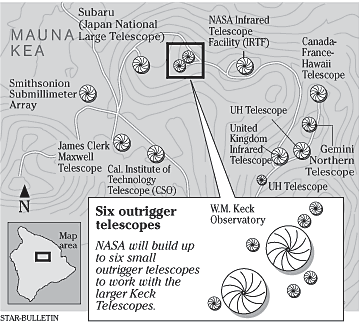NASA plans 6 new scopes
A $50 million project on Mauna Kea
would add telescopes to aid the
existing Keck ones
HILO » NASA has decided to build up to six relatively small outrigger telescopes around the two giant Keck telescopes on Mauna Kea, a plan that has been opposed by some environmentalists and native Hawaiian activists.
The $50 million project would consist initially of four 35-foot-high domes arranged around the existing 111-foot-high Keck domes. The main mirror of each outrigger would be 6 feet in diameter compared with the 33-foot diameter of the mirrors of the two Keck telescopes.
By combining the light of all of the telescopes, large and small, in a process called interferometry, the equivalent of a telescope with a mirror 275 feet across will be created.
The combined instruments would do studies ranging from looking at the wobble of stars to detect planets around them, to looking at dust and gas in the process of forming new stars.
The University of Hawaii supervises the mountaintop. The National Aeronautics and Space Administration will build the telescopes. The parent organization of the Kecks will also operate the new telescopes.
Rolf-Peter Kudritski, director of the University of Hawaii Institute for Astronomy, which has been seeking approval of the project for NASA, said the decision was based on the fact that Mauna Kea is a "scientifically superior site."
He noted that the project consists of four small telescopes that will be built on existing parking areas around the Keck telescopes.
Building just four outriggers is technically difficult, so it is just as well that there is no money now for the two additional ones that could come later, he said.
NASA's decision notes that if the Keck site is not used for some reason, the project could be built in the Canary Islands or even at one of two California sites, Mount Wilson or Mount Palomar, although those would involve "reduced science."
"No alternate site matches the scientific capability of the W.M. Keck on Mauna Kea," the NASA document says.
But Haunani Apoliona, Office of Hawaiian Affairs chairwoman, said the fact that those options are still being considered shows that the final decision has not yet been made.
"I would say it's not over yet," she said, noting that NASA says the decision is "subject to the availability of funds."
OHA had sued NASA complaining that the initial environmental study for the outriggers was not well done. When NASA eventually did a full environmental impact study, they met the requirements of the law, she said last night.

The outrigger domes will not be visible from Hilo, although they will be seen from Waimea, according to the environmental impact statement.
The project has been opposed by environmentalists such as the Sierra Club, who have concerns such as threats to insects, and by some Hawaiian groups, such as the Order of Kamehameha, concerned that observatories disrupt the spirituality of Mauna Kea.
NASA's July 22 signing of a "record of decision" permitting the project, followed by release of the document yesterday, does not end opposition.
More steps lasting several months must be taken before construction can start.
The project must still be reviewed by the Office of Mauna Kea Management at the University of Hawaii at Hilo. That agency will make a recommendation to UH-Hilo Chancellor Rose Tseng, who will report to UH interim President David McClain.
Final approval must be given by the university Board of Regents. Additional comment would be heard by the board before their decision.
Big Island Sierra Club representative Nelson Ho said NASA failed to heed cultural, economic and site consideration raised by opponents. He was one of several people who opposed the project in a hearing by the Department of Land and Natural Resources.
But the record of decision notes that a person serving as a cultural monitor, as well as an archaeologist, will oversee all construction at the project.
Ho said the project will have little economic benefit for the Big Island, despite its overall $50 million price tag.
E-mail to City Desk
[News] [Business] [Features] [Sports] [Editorial] [Do It Electric!]
[Classified Ads] [Search] [Subscribe] [Info] [Letter to Editor]
[Feedback]
